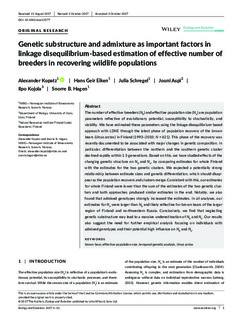| dc.contributor.author | Kopatz, Alexander | |
| dc.contributor.author | Eiken, Hans Geir | |
| dc.contributor.author | Schregel, Julia | |
| dc.contributor.author | Aspi, Jouni | |
| dc.contributor.author | Kojola, Ilpo | |
| dc.contributor.author | Hagen, Snorre | |
| dc.date.accessioned | 2017-11-22T11:49:15Z | |
| dc.date.available | 2017-11-22T11:49:15Z | |
| dc.date.created | 2017-11-20T15:28:54Z | |
| dc.date.issued | 2017 | |
| dc.identifier.citation | Ecology and Evolution. 2017 | nb_NO |
| dc.identifier.issn | 2045-7758 | |
| dc.identifier.uri | http://hdl.handle.net/11250/2467547 | |
| dc.description.abstract | The number of effective breeders (Nb) and effective population size (Ne) are population parameters reflective of evolutionary potential, susceptibility to stochasticity, and viability. We have estimated these parameters using the linkage disequilibrium-based approach with LDNE through the latest phase of population recovery of the brown bears (Ursus arctos) in Finland (1993–2010; N = 621). This phase of the recovery was recently documented to be associated with major changes in genetic composition. In particular, differentiation between the northern and the southern genetic cluster declined rapidly within 1.5 generations. Based on this, we have studied effects of the changing genetic structure on Nb and Ne, by comparing estimates for whole Finland with the estimates for the two genetic clusters. We expected a potentially strong relationship between estimate sizes and genetic differentiation, which should disappear as the population recovers and clusters merge. Consistent with this, our estimates for whole Finland were lower than the sum of the estimates of the two genetic clusters and both approaches produced similar estimates in the end. Notably, we also found that admixed genotypes strongly increased the estimates. In all analyses, our estimates for Ne were larger than Nb and likely reflective for brown bears of the larger region of Finland and northwestern Russia. Conclusively, we find that neglecting genetic substructure may lead to a massive underestimation of Nb and Ne. Our results also suggest the need for further empirical analysis focusing on individuals with admixed genotypes and their potential high influence on Nb and Ne. | nb_NO |
| dc.language.iso | eng | nb_NO |
| dc.rights | Navngivelse 4.0 Internasjonal | * |
| dc.rights.uri | http://creativecommons.org/licenses/by/4.0/deed.no | * |
| dc.subject | Populasjonsgenetikk | nb_NO |
| dc.subject | Population genetics | nb_NO |
| dc.subject | Brunbjørn | nb_NO |
| dc.subject | Brown bear | nb_NO |
| dc.title | Genetic substructure and admixture as important factors in linkage disequilibrium-based estimation of effective number of breeders in recovering wildlife populations | nb_NO |
| dc.type | Journal article | nb_NO |
| dc.type | Peer reviewed | nb_NO |
| dc.description.version | publishedVersion | nb_NO |
| dc.rights.holder | © 2017 The Authors. This is an open access article under the terms of the Creative Commons Attribution License, which permits use, distribution and reproduction in any medium, provided the original work is properly cited. Ecology and Evolution published by John Wiley & Sons Ltd | nb_NO |
| dc.subject.nsi | VDP::Økologi: 488 | nb_NO |
| dc.subject.nsi | VDP::Ecology: 488 | nb_NO |
| dc.source.pagenumber | 12 | nb_NO |
| dc.source.journal | Ecology and Evolution | nb_NO |
| dc.identifier.doi | 10.1002/ece3.3577 | |
| dc.identifier.cristin | 1516224 | |
| cristin.ispublished | true | |
| cristin.fulltext | original | |
| cristin.qualitycode | 1 | |

